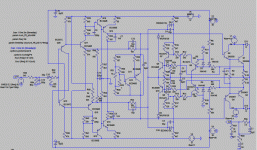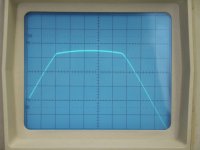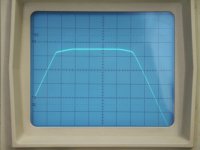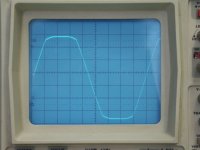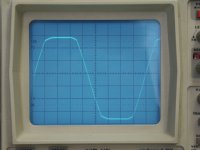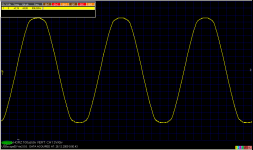Clipping cannot be avoided. In clipping any reasonable relation between input and output, i.e. gain, proverbially disappears as in the time domain, an increase in input is not responded with increase in output. Hence negative feedback does not work. If no SOAR protection is provided and no overcurrent protection
clipping can destroy the power BJTs . The attachment shows a schematic of an amp ( not with the original BJTs except the SOAR protection) that has been diy'ed plenty often. It features a carefully designed lead/lag compensation, and a "lavishly" designed SOAR protection. Since the VAS has close to zero CMRR a second PSU is necessary. In spite of the protection a couple of these amps have failed with burnout as a consequence of clipping. It should not happen but it did. In the original schematic Q1 throu Q4 are Sanken LAPTs with fts of 100 Mhz and 40 MHz resp. The burnout appears to have initiated in the drivers Q2,Q4.
One of the most promising ideas is to have clipping occur in a soft manner -soft clipping- "before" the power stage to ensure NFB is always working.
So far however I did not come up with a solution which does not inject
errors to the signal far below clipping such as spikes.
clipping can destroy the power BJTs . The attachment shows a schematic of an amp ( not with the original BJTs except the SOAR protection) that has been diy'ed plenty often. It features a carefully designed lead/lag compensation, and a "lavishly" designed SOAR protection. Since the VAS has close to zero CMRR a second PSU is necessary. In spite of the protection a couple of these amps have failed with burnout as a consequence of clipping. It should not happen but it did. In the original schematic Q1 throu Q4 are Sanken LAPTs with fts of 100 Mhz and 40 MHz resp. The burnout appears to have initiated in the drivers Q2,Q4.
One of the most promising ideas is to have clipping occur in a soft manner -soft clipping- "before" the power stage to ensure NFB is always working.
So far however I did not come up with a solution which does not inject
errors to the signal far below clipping such as spikes.
Attachments
There is a soft clipping in a Randy Slone's design. See "The Audiophile´s Project Sourcebook", design Fig. 6-21, from page 172 to 178.
Amazon.com: The Audiophile's Project Sourcebook: 80 High-Performance Audio Electronics Projects (0639785330820): G. Randy Slone, G. Randy Slone: Books
Amazon.com: The Audiophile's Project Sourcebook: 80 High-Performance Audio Electronics Projects (0639785330820): G. Randy Slone, G. Randy Slone: Books
in general clipping itself shouldn't stress output devices - nice low Vce sat, load limited current give low power loss in the device
limiting base/gate drive to safe levels is required but not difficult
more dangerous for the output stage is leaving clipping, turning off the saturated device while possibly having high frequency oscillation bursts as the the earlier feedback stages "unwind" from saturation - slow turn-off will give high "shoot-thru" currents and stress the device on the the other rail
limiting base/gate drive to safe levels is required but not difficult
more dangerous for the output stage is leaving clipping, turning off the saturated device while possibly having high frequency oscillation bursts as the the earlier feedback stages "unwind" from saturation - slow turn-off will give high "shoot-thru" currents and stress the device on the the other rail
in general clipping itself shouldn't stress output devices - nice low Vce sat, load limited current give low power loss in the device
limiting base/gate drive to safe levels is required but not difficult
more dangerous for the output stage is leaving clipping, turning off the saturated device while possibly having high frequency oscillation bursts as the the earlier feedback stages "unwind" from saturation - slow turn-off will give high "shoot-thru" currents and stress the device on the the other rail
Yes certainly if ie max is not exceeded the clipping device should not be harmed.
It is the effects of saturation in the pre-drivers that result from NFB failing that can kill the device that should be off ( VCe max ) but isn't. Preventing saturation with diode clamps (preferably germanium diodes ) has been tested.
I have once designed a (supposedly) saturation-free predriver but never built it. Typically such predrivers have very low gain per stage
Clipping cannot be avoided. In clipping any reasonable relation between input and output, i.e. gain, proverbially disappears as in the time domain, an increase in input is not responded with increase in output. Hence negative feedback does not work. If no SOAR protection is provided and no overcurrent protection
clipping can destroy the power BJTs . The attachment shows a schematic of an amp ( not with the original BJTs except the SOAR protection) that has been diy'ed plenty often. It features a carefully designed lead/lag compensation, and a "lavishly" designed SOAR protection. Since the VAS has close to zero CMRR a second PSU is necessary. In spite of the protection a couple of these amps have failed with burnout as a consequence of clipping. It should not happen but it did. In the original schematic Q1 throu Q4 are Sanken LAPTs with fts of 100 Mhz and 40 MHz resp. The burnout appears to have initiated in the drivers Q2,Q4.
One of the most promising ideas is to have clipping occur in a soft manner -soft clipping- "before" the power stage to ensure NFB is always working.
So far however I did not come up with a solution which does not inject
errors to the signal far below clipping such as spikes.
There are two soft clipping approaches I have tried. One is what I call the Klever Klipper, which is described on my website at Cordell Audio: Home Page. That circuit provides an adaptive soft clipping threshold ahead of the entire power amplifier, outside its feedback loop. It prevents the power amplifier itself from ever clipping. Its clipping level adapts to the available power supply voltage so no dynamic headroom is lost. The tradeoff with circuits like that is that the distortion caused by the clipping diodes begins well below the full power output of the amplifier. This is by definition a necessity if indeed the clipping behavior is to be soft. Such distortion rising well below full power output is quite benign and somewhat tube-like, but it will disappoint those who are only into the numbers game.
The other approach involves Baker clamps like those I used in my MOSFET EC amplifier paper. These clamp the output of the VAS before it or the output stage can saturate. With ordinary global feedback, the resulting clipping is still quite sharp and some stages in the amplifier go into cutoff. In that design, the current diverted from the VAS by the Baker clamp diodes is returned to ground through the collectors of a pair of transistors that provide the bias for the Baker clamp diodes. If instead those collectors are returned to ground through a resistor, an "output voltage" is produced. This voltage can be returned to the input stage to keep the feedback loop closed during clipping. This results in a softer clip wherein the amplifier comes out of clipping more cleanly because most of the stages never went into cutoff.
Cheers,
Bob
there's anoyher method if you don't mind some compression. some pro-audio amps have opto compression that limits the amplifier output to just below clipping. it doesn't introduce any distortion to the signal itself, just reduces the overall gain of the amplifier. if you test the amp with a sine wave source, you get the amp just below clipping and the output amplitude doesn't go any higher, but a front panel LED informs you that you are overdriving the amp. i have rarely seen amps of this type come in for shorted outputs, except when the amp has been run with the limiter turned off. some models have a setting for fast or slow response of the limiter to allow for short transients without activating the limiter.
Thanx for these ideas. Most possibly professional amps intended for on stage usage in live performances must be equipped with perfectly working soft clipping because there 100% reliability is mandatory. I think Bob's proposal Baker clamps returning a clipping-level proportional feedback which yields "soft compression" in combination with keeping the critical predriver VAS stages out of saturation promises to be a almost professional solution.
However testing a sim with a complex load such as a 2 way passive crossover with
baffle step equalisation and such, simulating the speakers as inductor with serial R of voice coil ( that is very simple and incorrect but..) yields a couple of surprises. For ex amps featuring thd as low as 0.0something % thd now read a solid 3% because odd harmonics go up. Such a sim demonstrates quite well one cannot go without SOAR protection as the phase shifts "demand" current from the device already stressed by max VCE.
However testing a sim with a complex load such as a 2 way passive crossover with
baffle step equalisation and such, simulating the speakers as inductor with serial R of voice coil ( that is very simple and incorrect but..) yields a couple of surprises. For ex amps featuring thd as low as 0.0something % thd now read a solid 3% because odd harmonics go up. Such a sim demonstrates quite well one cannot go without SOAR protection as the phase shifts "demand" current from the device already stressed by max VCE.
Last edited:
I believe a DSP could identify the frequency of the largest non-transient waves,
and add or subtract "soft clipping" harmonics of the offending notes alone. Thus
sidestep the hetrodyne IMD problem for other simultaneously passing frequencies.
Perhaps the effect would be akin to each musician having their own MI amplifier?
For sharp transients of no particular frequency, I'm less sure what to do.
and add or subtract "soft clipping" harmonics of the offending notes alone. Thus
sidestep the hetrodyne IMD problem for other simultaneously passing frequencies.
Perhaps the effect would be akin to each musician having their own MI amplifier?
For sharp transients of no particular frequency, I'm less sure what to do.
Last edited:
Mr.Cordell;
I, for one, would be MOST interested in your Klever Klipper idea - unfortunately your website has no information on it regarding this circuit. I make solid-state guitar amplifiers that rely on a standard BJT differential input, a MOSFET VAS, and IRF610/IRF9610 drivers for a pair of BJT outputs. The output transistors use 4.7ohm emitter resistors bypassed by a power diode that prevents them from being heavily saturated (and provides a higher output impedance ).
).
Overall DC feedback is taken from the output transistor emitters, but the AC feedback loop only includes the drivers, and uses the JLLH style of compensation.
I, for one, would be MOST interested in your Klever Klipper idea - unfortunately your website has no information on it regarding this circuit. I make solid-state guitar amplifiers that rely on a standard BJT differential input, a MOSFET VAS, and IRF610/IRF9610 drivers for a pair of BJT outputs. The output transistors use 4.7ohm emitter resistors bypassed by a power diode that prevents them from being heavily saturated (and provides a higher output impedance
Overall DC feedback is taken from the output transistor emitters, but the AC feedback loop only includes the drivers, and uses the JLLH style of compensation.
Thanx for these ideas. Most possibly professional amps intended for on stage usage in live performances must be equipped with perfectly working soft clipping because there 100% reliability is mandatory. I think Bob's proposal Baker clamps returning a clipping-level proportional feedback which yields "soft compression" in combination with keeping the critical predriver VAS stages out of saturation promises to be a almost professional solution.
However testing a sim with a complex load such as a 2 way passive crossover with
baffle step equalisation and such, simulating the speakers as inductor with serial R of voice coil ( that is very simple and incorrect but..) yields a couple of surprises. For ex amps featuring thd as low as 0.0something % thd now read a solid 3% because odd harmonics go up. Such a sim demonstrates quite well one cannot go without SOAR protection as the phase shifts "demand" current from the device already stressed by max VCE.
Hi Hafran,
These are good points. Even apart from clipping or activation of protection circuits, I believe that THD can be higher into certain reactive loads because of the different phase relationship between voltage and current under those conditions. Sometimes this sort of thing may be responsible for bench test results not correlating well with listening tests. I don't think too many people measure THD with speaker loads (real or simulated).
I believe it is equally true that some amplifiers may burst into parasitic oscillations under the unique V-I combinations that a speaker load may present. Such instabilities might go unnoticed or not happen in conventional testing with resistive loads.
If you have a really big output stage you can often get away without V-I limiters, but it is a risk tradeoff. Many people hold V-I limiters responsible for serious sonic degradation. This is certainly true if they are called upon to act. They got a very bad reputation in the early days of SS amplifiers because too few transistors were used in the output stages and those transistors did not have great SOA. As a result, agressive V-I limiters were needed to protect the amplifiers. Nowadays, V-I limiters should almost never have to act, and should not degrade sound quality except under the most severe cases where you would want to save the amplifier from destruction.
Cheers,
Bob
Hello,
If your system clips, it is a poorly engineered system. If clipping occurs, by definition you are using too small amp or your speakers are having too less sensitivity.
That is, efforts should be aimed in preventing clipping rather than healing the symptoms.
- Elias
If your system clips, it is a poorly engineered system. If clipping occurs, by definition you are using too small amp or your speakers are having too less sensitivity.
That is, efforts should be aimed in preventing clipping rather than healing the symptoms.
- Elias
Clipping cannot be avoided.
I mentioned the interview with Charles Hansen the maker of Ayre amps.Hi Hafran,
These are good points. Even apart from clipping or activation of protection circuits, I believe that THD can be higher into certain reactive loads because of the different phase relationship between voltage and current under those conditions. Sometimes this sort of thing may be responsible for bench test results not correlating well with listening tests. I don't think too many people measure THD with speaker loads (real or simulated).
Cheers,
Bob
Hansen claims no local feedback in power stages at all produces far less reactive distortion than any kind of local feedback especially poor is voltage feedback that is sometimes used to achieve lowest output impedance and high damping factors.
I mentioned the interview with Charles Hansen the maker of Ayre amps.
Hansen claims no local feedback in power stages at all produces far less reactive distortion than any kind of local feedback especially poor is voltage feedback that is sometimes used to achieve lowest output impedance and high damping factors.
so he is dissing emitter follwer outputs?
Cherry has JAES articles on output stage distortion that suggest there's really not much going on there if the stage is capable of handling the full I,V locus
feedback can make clipping/deadband/dynamic underbias worse as it tries to make the output do what it simply can't
but when the feedback is around a stage that reamins "small signal linear" over the measured range of real or reactive current sufficient feedback does reduce distortion of all measureable orders at audio frequencies
Last edited:
Well designed amp haven't any problems with recovery after clipping. Some examples: mosfet amp with BC's error correction and variable switching voltage gain in VAS close below clipping. 1 kHz, RMS voltage below clipping is 32 V into 8 Ohms: level of switching...
Attachments
- Status
- This old topic is closed. If you want to reopen this topic, contact a moderator using the "Report Post" button.
- Home
- Amplifiers
- Solid State
- Recovery from clipping, soft clipping
